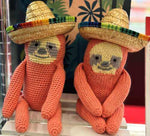*** Free UK delivery on orders over £75 ***
Menu
-
- New
-
Yarn
- Stitching
-
Hooks & Needles
-
Accessories
-
All Accessories
- Blocking
- Books and Magazines
- Buttons
- Cable Needles
- Chart Keepers
- Darning Needles and Pins
- Needle and Hook Cases
- Notebooks and Stationery
- Pom Poms
- Row Counters
- Rulers and Needle Gauges
- Scissors
- Sewing
- Stitch Holding Cords
- Stitch Markers
- Stitch Stoppers
- Swifts and Winders
- Wool Wash
- Yarn Bowls
- Yarn Snugs
- Other
- Bags
- Brands
-
All Accessories
-
Patterns & Kits
-
Gifts
- Sale
-
How to & Ideas
-
- Login

*** Free UK delivery on orders over £75 ***
What are the Different Types of Yarn?
June 21, 2022 5 min read

Years ago, it was common to call all types of knitting yarn "wool" - but nowadays, that's not the case. These days, keen knitters will find a wealth of yarn options to explore, each with their own unique characteristics. Grab your needles and let's delve into the world of types of yarn for knitting and crochet...
Contents
- How many different types of yarn are there?
- Types of yarn
- What are the best types of yarn for knitting?
- What are the best types of yarn for crocheting?
How many different yarn types are there?
This isn't an easy question to answer! There are dozens of different yarns available, from common fibres like wool and cotton to exotics like yak or alpaca, as well as acrylic novelty yarns. Even if you're just talking about types of wool yarn, you'll find differences between breeds of sheep.
Here's a guide to some of the most popular yarns that you'll find available nowadays:
Types of yarn
- Alpaca This gorgeous yarn comes from the adorable alpaca, a llama-like creature that hails from the Andes. Alpaca yarn is extremely soft, warm, and breathable, making it a pleasure to knit with. It has a fuzzy halo effect, which looks great in pieces like scarves and cowls. Pure alpaca yarn can stretch out of shape, so take care if you're making a fitted garment, and always wash a gauge swatch first to see how it behaves.
- Blue Faced Leicester This is a type of wool, from a breed of sheep native to the UK. It creates warm, cosy garments with wonderful stitch definition. It has a unique sheen that sets it apart from other types of wool, giving it a rich appearance. It's also softer than most wools, so it will feel better against your skin.
- British Yarns Most British yarns are made from sheep's wool, and they are renowned for their quality. The UK has a great climate for raising sheep, so these yarns are highly sought after. Some knitters prefer to choose British yarns for ethical or environmental reasons.
- Cotton Cotton is a nice fibre for summer garments, when you want something light and breezy. Cotton is comfortable to wear, machine-washable, and has great stitch definition; it's particularly good for crochet or knitting lace. It's also durable, and doesn't pill. On the downside, cotton doesn't have the elasticity of wool. That means it can stretch out of shape, particularly when wet, and it can be quite stiff to work with. If you've never knitted with cotton yarn before, you might find it hard to get used to at first.
- Merino Merino wool, which comes from a special breed of sheep most commonly raised in Australia, is extremely popular for all kinds of knitting projects. It's much softer than most wool, and it's very lightweight. Its moisture-wicking properties make it a particularly good choice for making socks, as it'll keep your feet dry all day long.
- Mohair Mohair comes from the Angora goat, and is a renowned luxury fibre. It's extremely lightweight, and has a beautiful drape that makes it work particularly well for projects like shawls. It's a very delicate fibre, and is not recommended for beginner knitters. Unpicking stitches to fix mistakes is difficult, as the fuzzy fibres stick tightly together. Mohair has a beautiful halo, but be warned - it may shed tiny fibres while you're knitting, leaving your sofa covered in fuzz!
- Nylon You're probably never going to knit with pure nylon, but this man-made fibre is often blended with wool or merino. Nylon is very strong and elastic, so adding it to a yarn makes your garments more durable. In particular, sock yarns are usually made with 25% nylon, which helps stop holes from forming at the toes and heels.
- Vegan Yarns You don't have to be vegan to enjoy these plant-based yarns! Vegan yarns are a cruelty-free alternative to wool or silk, and they're also very popular among knitters with wool allergies. Hypoallergenic vegan yarns include bamboo, which has a soft drape and a gorgeous sheen, and can be used as an alternative to silk. It also has moisture-wicking properties, making it a versatile, all-round good choice for a number of different projects. Linen yarns are another popular plant-based yarn, and are light, cool, and soft for summertime knitting. Linen is often blended with cotton to give you a stronger yarn with a great drape, ideal for light summer tops and flowing cardigans.
- Silk Silk is a stunning luxury fibre that feels soft against your skin. It regulates temperature wonderfully, keeping you cool in summer and warm in winter. Silk has a beautiful drape and an exquisite lustre, but on the downside it is inelastic, so the finished pieces may stretch out of shape. Silk is fragile when wet, so be sure to take care when handling it. To avoid this, silk is usually blended with other fibres.
- Sparkle Wool Sometimes we all need a bit of glitter in our lives! Sparkle wool can be made of different fibres, and has glitter woven into it. The sparkly element is woven deeply and securely into the yarn to prevent itchiness. It's great for making cute items for babies and kids, and for adding a bit of brightness to your winter wardrobe.
- Superwash Wool Wool can often turn to felt when put into the washing machine, so a superwash treatment stops this from happening. Superwash wool has been treated with a chemical coating on the outside of the fibre, making it machine-washable. It is easy to care for, making it a great choice for garments that you'll wear regularly, or for babies' clothes. Another bonus is that it doesn't pill like normal wool tends to. Superwash wool can feel slightly more slippery than normal wool, but apart from that, it has all the same properties.
- Yak Yarn For something truly exotic, try knitting with yak! The shaggy Mongolian beast products incredibly soft, warm yarn that's breathable and suitable for knitters with allergies to normal wool. Yak can shed small fibres, and its stitch definition is not as clear as other yarns, so it's not the best for cables or fancy lace. However, for many other knitting projects, it's hard to beat this luxury fibre.
What are the best yarns for knitting?
It depends on what you're going to be knitting. You should always consider the properties of the yarn and how they'll interact with your project. For example, a soft, drapey alpaca yarn makes a lovely scarf but may droop and sag if knitted into a jumper; you'd be better off choosing merino or regular wool, which has more body. If you're making a project with cables, look for a yarn with good stitch definition, and avoid fuzzy fibres like mohair, as all your hard work will disappear.
What are the best yarns for crochet?
Again, this will depend on what you're making. A lightweight summer top, a popular project for many crocheters, is usually best made from soft, breathable cotton. If you're making a large granny square blanket, you'll probably find that a cosy wool is the best choice.
Also in Yarn Guides

What is boucle yarn?
March 21, 2025 2 min read
Boucle yarn is a popular material for knitting that creates a unique textured fabric. Learn everything you need to know about boucle with our in depth guide!

How to crochet a magic circle
May 19, 2023 4 min read

5% off your first order when you join our email newsletter...
Be the first to know of new product releases and other exciting news! A discount code will be sent to your email straight away!

